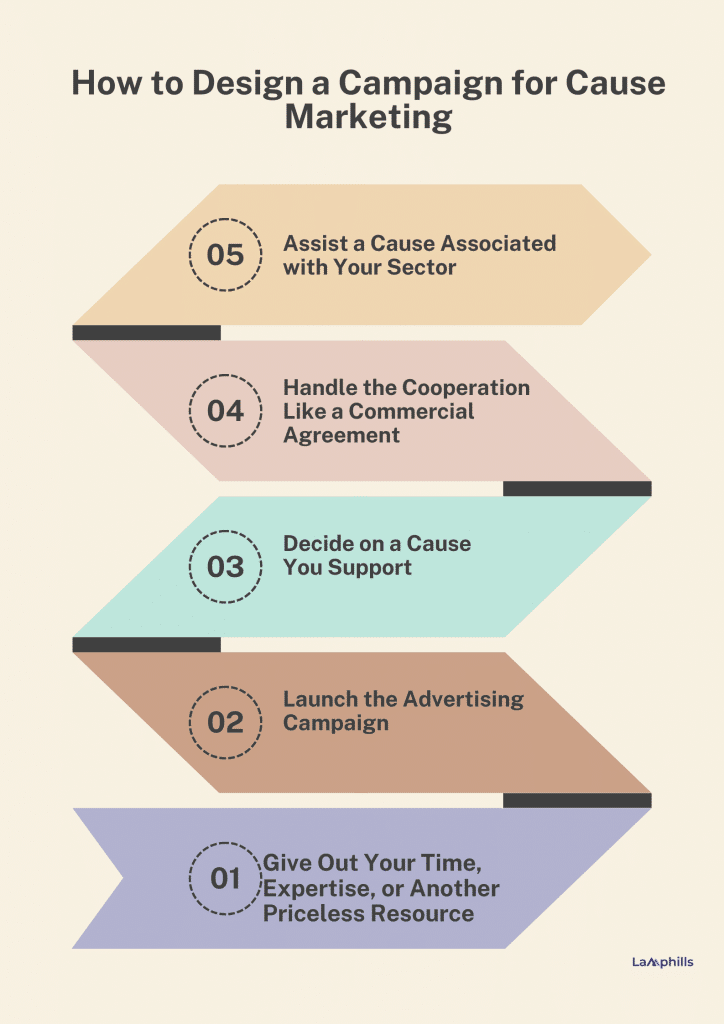As a writer experienced in corporate social impact, I’m frequently asked to explain one of today’s biggest marketing trends – cause-related marketing. You’ve definitely seen examples, like the iconic (RED) campaign where brands like Apple and Starbucks sell special product lines that fund the fight against AIDS. Or Pampers’ long-running program allowing customers to provide vaccines to moms and babies through their purchases.
But what exactly is cause marketing? At its core, it’s a collaborative strategy where for-profit businesses and non-profit causes team up for mutual benefit. Companies promote and fund the cause, often through product sales or promotional campaigns. In return, they enjoy positive brand imagery, customer loyalty, and the feel-good glow of giving back.
But that’s just on the surface. Let’s take a look at this in more detail. In this article, I’ll go over all you should know about cause-related marketing with powerful real-world examples and strategies to amplify your brand’s “do-good” storytelling.
Key Points
- Cause-related marketing is commonly defined by the business sector as an alliance between a for-profit company and a charitable organization that benefits both parties
- Successful cause-related marketing campaigns can significantly improve a company’s reputation and brand image
- Businesses may establish a reputation for being compassionate and socially conscious by partnering with causes that appeal to their target market
- Cause-related marketing can also assist companies in growing their clientele
- Businesses might raise their profit margins and produce higher revenue by capitalizing on this market niche
Understanding Causes-Related Marketing
Cause-related marketing is an effective tactic that transcends conventional marketing techniques. It is best described as a collaboration in which a for-profit company and a nonprofit organization work together to generate shared value. The company hopes to improve its reputation and financial results while supporting a social or environmental cause through this partnership.
However, cause-related marketing goes beyond a straightforward sponsorship or donation. It calls for a sincere desire to change things and thoroughly comprehend the issue.
What Is Cause-Related Marketing
Cause-related marketing is promoting a particular idea, cause, or objective rather than a particular company, sound, or service, as the name suggests.
Cause-related marketing is an organization’s promotional activity wherein it endorses a social or charity cause; this is typically done in conjunction with the company’s products and services as a package or tie-in. Also, cause-related marketing is a means of communicating corporate social responsibility (CSR) to a broad audience, which shows how an organization’s social responsibility contributes to certain societal advantages. A promotional campaign is frequently the format of cause-related marketing with a nonprofit or charity supporting a particular social cause. Cause-related marketing is commonly defined by the business sector as an alliance between a for-profit company and a charitable organization that benefits both parties.
It is also a collaboration in which a corporation and a nonprofit organization collaborate to create shared value. The company hopes to improve its reputation and financial results while supporting a social or environmental cause through this partnership.
Cause-related marketing has the potential to benefit charitable organizations as well as businesses when done correctly. In one of the companies I worked for in the past, we capitalized on consumers’ emotional connection to social and environmental issues by associating the brand with a cause. I have come to discover that this relationship increases consumer engagement and sales and fosters brand loyalty. Nonprofit organizations, on the other hand, gain from the assets and knowledge that companies provide.
How to Design a Campaign for Cause Marketing

I can tell you for a fact that for-profit corporations using cause marketing get the opportunity to strike a balance between their social obligation and financial gain. However, a strong team and an experienced marketer are required to achieve the right mix.
So, because I have seen this work first hand for companies I have worked with, here are proven actions to take to launch your cause marketing campaign:
#1. Give Out Your Time, Expertise, or Another Priceless Resource
Many businesses base their cause marketing efforts on things like giving goods or services—actions that benefit the partner group. While all NGOs benefit from financial contributions, offering your time or talents puts a face on your business. Additionally, it can establish strong connections between your philanthropic contributions and your goods and services.
#2. Launch the Advertising Campaign
Your audience should be motivated to take constructive action by your campaign. You may give your marketing efforts a true meaning by committing the entire campaign to the cause. Your company may impact more than just its balance sheet by igniting dialogue with its audience.
#3. Decide on a Cause You Support
Employee belief in the cause strengthens a cause marketing strategy. They will probably work more, support the cause during their free time, and perhaps even feel inspired to volunteer. The ideal way to execute this campaign is when your staff is enthusiastic about advancing the cause.
#4. Handle the Cooperation Like a Commercial Agreement
Working with the nonprofit’s members will help you identify the advantages for both parties so that your collaboration would benefit both o parties. The campaign would make your brand more visible.
I have personally experienced how this works.
The nonprofit organization offered to list my company as a major sponsor on campaign-related materials or acknowledge our support in an email blast on its website and social media. So, I would advise you to collaborate to determine how to incorporate the organization’s branding into your marketing plan and how to develop language that connects the two.
#5. Assist a Cause Associated with Your Sector
I can tell in confidence you that the best partnerships benefit all parties involved. It makes sense for your business to support a worthy cause so that consumers will continue to identify your name with that cause even after the campaign has ended. For instance, if your business produces and markets hair care items, you can consider collaborating with a charity that fits cancer patients who have lost their hair with wigs made from donated hair. Increasing hair donations and spreading the word about the wig program may be the two main objectives of your campaign.
How To Manage A Successful Marketing Campaign Associated With Causes
With the design in place and initiated, you’ll need to be able manage the campaign. From experience, here’s how to get started after you’ve determined that cause-related marketing should be included in your plans since it fits with your vision and mission:
#1. Recruit Clients
Find a way to involve your customers so they feel like they are part of this cause. Encourage them to purchase associated goods, make charitable contributions, or participate in activities by demonstrating the difference their actions will make.
To increase visibility, you can also support user-generated content initiatives. Make a hashtag and encourage those who follow you to post pertinent stuff to turn them into faithful supporters of the cause.
#2. Look for a Related Cause
Finding a cause that aligns with your mission and vision is the first and most crucial step in developing a strategy. Once you’ve identified it, it will be simpler to communicate it to the nonprofit organizations you want to collaborate with to create something.
Recall that to guarantee client involvement and maximize benefits in both ways, having a similar audience is critical. To close the transaction, accomplish good things, enjoy yourself, and decide what kind of endeavor you want to launch, Is it a branded event or a new product? Your audience will heavily influence this choice.
#3. Organize Your Marketing Strategy
It’s time to publicize it once you’ve defined your alliances’ specifics and discovered why your heart races. Create unique campaigns and make use of the marketing channels that are currently working for you.
For instance, you can create a specific email campaign to notify your clients about your most recent activities if you’re hosting a charitable event. Likewise, if you go that route, you can utilize email services like as Moosend and streamline this process considerably. Alternatively, employ other powerful marketing instruments like social media to broaden your audience.
Robust Case Studies of Cause-related Marketing
There is no shortage of societal issues that require immediate attention, and as a result, cause-related marketing initiatives are just as varied as their profit-driven competitors. Here are some very well-done cause-based marketing campaign examples that may provide some creative spark for your cause-based marketing initiatives.
#1. World Wildlife Fund
Among the world’s most committed conservation groups is the World Wildlife Foundation. While WWF is most recognized for its advocacy efforts to prevent the extinction of endangered species, the organization is also heavily involved in habitat protection.
Over the years, WWF has started hundreds of cause-related projects; however, one recent green marketing effort that brought attention to the urgent threats of deforestation in the rainforest stood out in particular. In the campaign’s creative, a partially clear-cut rainforest that resembled human lungs was depicted. The picture, which was created by the French firm TBWA/Paris, served as a potent reminder of the need to save the world’s rainforests for the sake of all living things, including animals.
#2. The Month of Veganuary
The year 2017 was a whopping success for plant-based diets. According to data from the Vegan Society, the number of vegans in the UK has risen by 350% in the last ten years. According to a recent report from a company that makes protein bars and powders, there has been a nearly 140% surge in the demand for plant-based food manufacturing. Veganism is predicted to be the most significant culinary trend of the year, according to data from meal delivery service, Only Eat, which saw a 987% spike in demand for vegan alternatives in 2017.
#3. The America Feeding Program
America has one of the worst rates of child poverty in the world despite being one of the wealthiest countries in the world. Few aspects of poverty are as harmful or even fatal as hunger, which affects one in five children in the United States.
One of the busiest nonprofits in the country, Feeding America strives relentlessly to eradicate food insecurity in the country’s poorest and most vulnerable communities. Over 46 million individuals depend on Feeding America programs and food banks annually to help them make ends meet. The Feeding America network, which serves one in seven Americans, is made up of more than 200 food banks and 60,000 food pantries.
#4. The Month of November
Millions of men worldwide unite every November to support the most admirable cause: bringing attention to men’s significant health problems by refusing to shave their top lips. Movember is an annual tradition that has gained tremendous popularity due to this unusual phenomenon.
#5. Every Town for the Safety of Firearms
The FBI defines a mass shooting as any incidence in which at least four people—not including the gunman—are shot and killed at the same site while using weapons in the same incident.
By this measure, nearly every day in America in 2017 saw a mass shooting.
No matter how you feel about the Second Amendment, there is no denying that America has a particular problem with gun violence. The horrifying scope of the issue becomes evident when you begin to examine the data on firearm-related fatalities in the United States, even though the answer does not.
While there are several advocacy groups for gun control in the United States, Everytown for Gun Safety is one of the biggest and busiest. After Moms Demand Action for Gun Sense in America and Mayors Against Illegal Guns merged, the group was established in 2014.
Examples of Cause Marketing Strategy
There are numerous ways to implement cause marketing based on the business, industry, budget, and location. For some fantastic charity marketing examples, continue reading.
#1. Obtaining a Licenses
The partnered company’s payment to utilize the nonprofit’s branding on its products raises money for this campaign. Upon purchasing a branded product, a triggered gift to the nonprofit organization is made. For instance, a credit card firm might use a cause’s emblem to appear on their cards. The credit card firm donates a portion of purchases made with the card to charitable organizations when they are made at specific establishments.
#2. Point of Sale
Donations are gathered for this kind of campaign at the register or even at the storefront. Customers will be asked whether they would like to contribute to the cause sponsored by the cashier or campaign representative. They might exchange small trinkets like candies, stickers, or company details. By only asking customers to donate at checkout, several charities have partnered with businesses to carry out an effective fundraising drive.
#3. Worker Involvement
Using employees as volunteers for a social cause, the corporation leverages another resource. My company allows employees to contribute their time to a cause they choose on paid days.
#4. Promotion of Messages
This kind of cause campaign involves an organization allocating resources to raise awareness. The business merely uses advertising, promotional materials, or other attention-grabbing strategies to promote and amplify the cause’s message.
#5. Triggered Contribution
Triggered purchase donations set aside a particular percentage of the product’s purchase price and contribute it to the featured charity. For example, a diner purchases a meal at a sponsored restaurant. While the pricing remains the same, the venue donates a predetermined portion of the proceeds to their selected cause.
Benefits for Businesses of Cause-Related Marketing
Businesses can gain significantly from cause-related marketing, both in terms of their financial success and reputation.
#1. Improving The Image And Reputation Of The Brand
Successful cause-related marketing campaigns can significantly improve a company’s reputation and brand image. Businesses may establish a reputation for being compassionate and socially conscious by partnering with causes that appeal to their target market. This will draw in customers who respect ethical business practices.
An illustration of a company’s dedication to sustainability might be a partnership with a nonprofit dedicated to environmental conservation. The company can establish a reputation as ecologically responsible by supporting reforestation programs, adopting eco-friendly practices, and encouraging efforts like lowering carbon footprints. This good association may make customers who care about the environment more dependable and loyal.
Furthermore, cause-related marketing can assist companies in setting themselves apart from rivals. When presented with various options, customers are more inclined to select a brand that shares their values. Businesses can differentiate themselves and draw in clients with similar values by actively supporting a cause and publicizing this dedication through marketing efforts.
#2. Increasing Revenue and Profit Margins
Cause-related marketing can directly impact a company’s sales and profit margins when done well. So, I did research that indicates buyers are prepared to shell out more money for goods or services supporting a cause. Businesses might raise their profit margins and produce higher revenue by capitalizing on this market niche.
For example, a clothing company encouraging ethical manufacturing and fair trade methods may draw customers who value ethical and sustainable fashion. These customers believe that goods that reflect their values are of a higher calibre and are socially conscious; hence, they are frequently ready to pay a premium. The company successfully conveys its dedication to sustainability and fair trade through cause-related marketing.
Cause-related marketing can also assist companies in growing their clientele. When a brand supports a cause, it might draw in new clients who may not have known about or been intrigued by the brand before. Businesses can reach a wider audience and attract new clients by conveying their brand’s beliefs and charitable endeavours.
To sum up, businesses can reap several advantages from cause-related marketing, such as improved brand image and reputation, increased consumer involvement and loyalty, and increased sales and profit margins. Businesses may stand out from the competition, create emotional connections with their target audience, and access the expanding market of socially conscious consumers by consciously identifying with a cause that appeals to them.
#3. Raise Customer Engagement And Loyalty
Nowadays, firms that show a dedication to environmental or social problems tend to attract more and more attention from consumers. Customers who are engaged and devoted to a brand and who identify with its values are likelier to stick with it over time than those attracted by cause-related marketing.
Emotional ties are one method of cause-related marketing that can improve consumer loyalty. Supporting a cause that holds personal significance for a company’s target market can arouse intense feelings and a feeling of unity in purpose. For instance, customers who have been directly impacted by cancer may identify with a business that donates a portion of its earnings to cancer research. These clients are more likely to become fiercely devoted to the brand,
Additionally, cause-related marketing enables companies to interact with clients more deeply. Businesses can encourage community and active consumer participation by involving them in the cause through various means, such as donation matching programs or volunteer opportunities. This interaction can boost brand advocacy and word-of-mouth referrals by deepening the relationship between the brand and its patrons.
Checklist on Cause-Related Marketing.pdf
Drawbacks of Cause-Related Marketing
However, do these marketing initiatives linked to causes always provide the best outcomes? Your well-meaning marketing strategy can backfire if you don’t present yourself in the best possible light. These are the two primary causes:
#1. Damage Reputation
First, let’s discuss for-profit companies. Customers may stop trusting you if they feel your actions are theatrical rather than proactive. Make sure you can fully support the goal of your business before deciding on one by doing extensive study.
For instance, you might disappoint some customers if you support a non-profit that fights climate change but continues to operate your business using unsustainable methods, such as plastic packaging. Therefore, apply these concepts to all your business units to prevent unfavourable consequences.
For similar reasons, nonprofit organizations should exercise caution when entering into partnerships. Ensured you have a similar vision and that your company employ ethical methods by researching them extensively. In the worst case, however, you might witness some donors withdrawing.
#2. It Could Expense More Than You Think
Organizations occasionally launch extensive cause-related campaigns without a thorough marketing strategy. As a result, they can invest more money than they can afford in a particular project without receiving a comparable return.
Thus, when starting a cause-related marketing campaign for the first time, set your budget, list all associated expenses, and ensure the gains outweigh the drawbacks.
What is another name for cause marketing?
Alternative terms. Campaigns for corporate social responsibility, affinity, cause, mission, and societal marketing are examples of marketing strategies.
Conclusion
Incorporating cause marketing into your standard marketing activities can have a huge positive impact on raising brand awareness. It further advances your cause and draws attention to the subject of your greatest love. There is no way that this isn’t advantageous to everyone concerned.
Related Articles
- The Top 10 Digital Marketing Agencies In Nigeria You Need to Know
- 10 Most Resounding Influencer Marketing Fails in History (Lessons to Learn)
- Top 10 Content Marketing Agencies in Nigeria 2024
- Marketing vs. Advertising: Building a Growth Engine for Your Business
- MARKETING PROJECT MANAGEMENT: Unveiling Insider Tips and Strategies for Success






